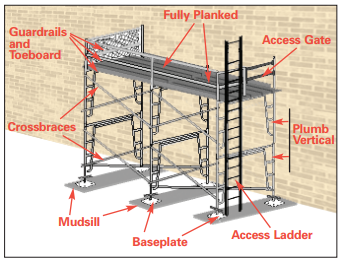Checking Out the Different Sorts Of Scaffolding Utilized in Construction Jobs
The building industry relies greatly on various kinds of scaffolding to fulfill certain job demands, each offering unique advantages and applications. Conventional structure scaffolding gives a strong foundation for basic jobs, while suspended scaffolding is crucial for work with high-rise frameworks. Other choices, such as system and rolling scaffolding, accommodate effectiveness and movement, specifically. The cantilever alternative confirms indispensable in city environments where area is constricted. Understanding the nuances of these scaffolding kinds is essential for optimizing security and performance on construction websites, motivating a better exam of their special attributes and applications.

Conventional Frame Scaffolding
Typical framework scaffolding is one of one of the most commonly made use of techniques in the construction sector because of its effectiveness and adaptability. This system includes upright and horizontal frameworks that are put together to develop a stable system for workers and products. The major components include vertical posts, horizontal ledgers, and diagonal dental braces, which together give a solid structure that can sustain substantial tons.
One of the crucial benefits of traditional frame scaffolding is its versatility to numerous construction projects, ranging from domestic structures to huge business frameworks. The modular layout allows for easy assembly and disassembly, making it efficient for both short-term and long-term projects. Additionally, the system can be personalized in height and width, fitting various structure styles and website conditions.
Security is vital in scaffolding applications, and standard framework systems are furnished with guardrails and toe boards to stop drops and make sure worker protection. Additionally, regular inspections and adherence to safety laws are critical in keeping the stability of the scaffold. On the whole, standard framework scaffolding remains a basic selection in the building market, providing a reliable system for labor and improving overall task effectiveness

Suspended Scaffolding
Put on hold scaffolding offers a special service for building and construction projects that need accessibility to raised surfaces, especially in scenarios where conventional framework scaffolding might be impractical. This sort of scaffolding is normally put on hold from the roof or upper degrees of a framework, using a system of wheels, systems, and ropes to produce a functioning space that can be adapted to different elevations.
Among the key benefits of suspended scaffolding is its flexibility. It can be easily repositioned or decreased to accommodate changes in building requirements, making it suitable for jobs such as home window setup, façade job, and maintenance on skyscraper structures. In addition, the marginal impact of put on hold scaffolding permits far better use ground room in metropolitan settings, where area is usually minimal.
Security is a crucial factor to consider in the usage of suspended scaffolding. On the whole, put on hold scaffolding offers a effective and reliable option for accessing hard-to-reach areas in numerous construction circumstances, improving both productivity and security on site.
System Scaffolding
System scaffolding, usually related to as a modern remedy in the scaffolding market, contains pre-engineered elements that can be promptly put together and adjusted for various building and construction jobs. Scaffolding. This sort of scaffolding is characterized by its modular layout, which enables flexibility and performance on task websites, accommodating different elevations and structural demands
Usually made from high-strength steel or aluminum, system scaffolding provides boosted resilience and security. The parts include vertical blog posts, horizontal ledgers, and angled dental braces, which adjoin securely, making sure a durable structure. The design typically includes standardized fittings, simplifying assembly and disassembly procedures, therefore reducing labor time and costs.

Rolling Scaffolding
Moving scaffolding is a versatile alternative to conventional fixed scaffolding, created for flexibility and ease of use on building and construction websites. This sort of scaffolding includes a platform sustained by frames with wheels, permitting workers to conveniently move it as needed. The mobility function considerably enhances efficiency, as it minimizes downtime connected with disassembling and setting up fixed scaffolding.
Commonly built from light-weight materials such as aluminum or steel, rolling scaffolding supplies a sturdy yet mobile remedy for projects needing constant repositioning - Scaffolding. It is particularly helpful in jobs such as painting, drywall setup, and electric work, where accessibility to different elevations and locations is essential
Security is extremely important in rolling scaffolding design, with functions such as securing wheels to stop unintentional activity when in use, and guardrails to shield employees from drops. Additionally, numerous designs are flexible in height, accommodating different job demands.
Cantilever Scaffolding

The layout of cantilever scaffolding usually involves utilizing brackets or arms anchored to a building or framework, allowing the system to extend exterior safely. Safety and security is critical; hence, these scaffolds need to be crafted to endure numerous tons and ecological conditions. Routine examination and maintenance are necessary to ensure architectural honesty click over here and employee security.
Cantilever scaffolding is preferred for its versatility and reliable usage of area, making it a preferred choice in metropolitan settings where space restrictions prevail. It promotes easier access to high elevations, eventually adding to the total efficiency of construction jobs. Just like all scaffolding kinds, correct training and adherence to safety and security standards are vital for employees using cantilever scaffolding.
Final Thought
Standard framework scaffolding supplies security, while put on hold scaffolding provides versatility for raised jobs. System scaffolding helps with quick setting up, and rolling scaffolding improves mobility for differing work settings.
Standard framework scaffolding provides a strong foundation for basic jobs, while put on hold scaffolding is essential for work on skyscraper frameworks.Rolling scaffolding is a flexible option to traditional set scaffolding, made for mobility and simplicity of usage on construction sites. As with all scaffolding types, proper training and adherence to safety and security criteria are crucial for employees making use of cantilever scaffolding.
Conventional frame scaffolding supplies stability, while suspended scaffolding offers adaptability for elevated tasks. System scaffolding facilitates fast assembly, and rolling scaffolding boosts movement for varying job settings.